
Sandringham is a village and civil parish in the north of the English county of Norfolk. The village is situated 2 kilometres (1.2 mi) south of Dersingham, 12 km (7.5 mi) north of King's Lynn and 60 km (37 mi) north-west of Norwich.

Brighton Beach railway station is located on the Sandringham line in Victoria, Australia. It serves the south-eastern Melbourne suburb of Brighton, and it opened on 21 September 1861 as Beach. It was renamed Brighton Beach on 1 January 1867.
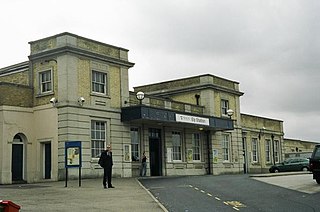
Ely railway station is on the Fen line in the east of England, serving the city of Ely, Cambridgeshire. It is 70 miles 30 chains (113.3 km) from London Liverpool Street and is situated between Waterbeach and Littleport stations on the Fen line to King's Lynn. It is an important junction for three other lines; the Ely to Peterborough Line, the Ipswich to Ely Line and the Norwich to Ely line.

Watlington railway station is on the Fen line in the east of England, serving the village of Watlington, Norfolk. It is 90 miles 70 chains (146.2 km) measured from London Liverpool Street and is situated between Downham Market and King's Lynn stations. Its three-letter station code is WTG.

King's Lynn railway station is the northern terminus of the Fen line in the east of England, serving the town of King's Lynn, Norfolk. It is 41 miles 47 chains (66.9 km) from Cambridge and 96 miles 75 chains (156.0 km) measured from London Liverpool Street.

Shrewsbury railway station is in Shrewsbury, Shropshire, England. Built in 1848, it was designated a grade II listed building in 1969.
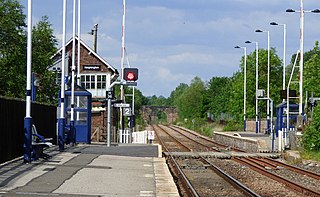
Heighington is a railway station on the Tees Valley Line, which runs between Bishop Auckland and Saltburn via Darlington. The station, situated 5 miles 62 chains (9.3 km) north-west of Darlington, serves the villages of Aycliffe and Heighington in County Durham, England. It is owned by Network Rail and managed by Northern Trains.
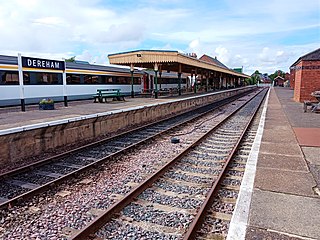
Dereham railway station is a railway station in the town of Dereham in the English county of Norfolk. The station is served by heritage services on the Mid-Norfolk Railway from Dereham to Wymondham.

Thuxton is a railway station in the village of Thuxton in the English county of Norfolk. The station is served by heritage services operated by the Mid-Norfolk Railway on the line from Dereham to Wymondham.

Wolferton is a village in north Norfolk, England, 2 miles west of Sandringham, 7½ miles north of King's Lynn and 37¼ miles northwest of Norwich.
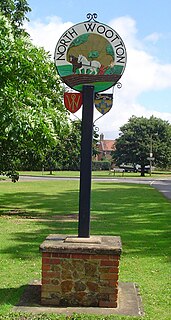
North Wootton is a village, civil parish and electoral ward near the town of King's Lynn in Norfolk, England. It covers an area of 32.33 km2 (12.48 sq mi) and had a population of 2,387 in 935 households at the 2001 census, the population including Babingley and increasing to 2,445 at the 2011 Census. For the purposes of local government, it falls within the district of King's Lynn and West Norfolk.

Heacham was a railway station which served the seaside resort of Heacham in Norfolk, England. Opened in 1862, the station became a junction where services left the King's Lynn to Hunstanton line for Wells on the West Norfolk Junction Railway, which opened in 1866. The station closed with the Hunstanton line in 1969.

Hardingham railway station is a railway station in the village of Hardingham in the English county of Norfolk. The station is periodically served by heritage services operated by the Mid-Norfolk Railway on the line from East Dereham to Wymondham.
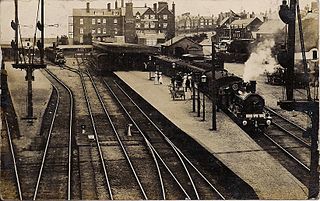
Hunstanton railway station served the seaside town of Hunstanton in Norfolk, England. Opened in 1862, the station was the northern terminus of the Lynn and Hunstanton Railway. The line was brought to public notice by John Betjeman in the British Transport Film John Betjeman Goes By Train. The station closed with the line in 1969.
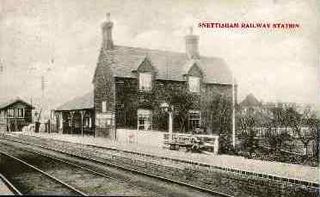
Snettisham was a railway station on the King's Lynn to Hunstanton line which served the village of Snettisham, a few miles north of King's Lynn in North Norfolk, England. Opened in 1862, the station closed along with the line in 1969.

Dersingham was a railway station on the King's Lynn to Hunstanton line which served the village of Dersingham, a few miles north of King's Lynn in North Norfolk, England.
North Wootton was a railway station on the King's Lynn to Hunstanton line which opened in 1862 to serve the village of North Wootton on the outskirts of King's Lynn in Norfolk, England. The station closed along with the line in 1969.
The West Norfolk Junction Railway was a standard gauge eighteen and a half-mile single-track railway running between Wells-next-the-Sea railway station and Heacham in the English county of Norfolk. It opened in 1866 and closed in 1953. At Wells the line made a junction with the Wells and Fakenham Railway and at Heacham it connected with the line from Hunstanton to Kings Lynn.

John Betjeman Goes By Train is a short documentary film made by British Transport Films and BBC East Anglia in 1962. The 10-minute-long film features future poet laureate John Betjeman as he takes a memorable journey by train from King's Lynn railway station to Hunstanton railway station in Norfolk, pointing out various sights and stopping off at Wolferton station on the Sandringham Estate and Snettisham station, where he extols the virtues of rural branchline stations. An early example of a Betjeman travelogue film, a similar idea was later used for his 1973 documentary Metro-land.

The Lynn and Hunstanton Railway was a line in Norfolk, England that opened in 1862. The railway was a major factor in developing Hunstanton as a seaside resort and residential community. The company was allied to the West Norfolk Junction Railway which built a line connecting Heacham, south of Hunstanton, to Wells-next-the-Sea that was not a financial success. The companies amalgamated in 1874 to form the Hunstanton and West Norfolk Railway, and in 1890 the company was sold to the Great Eastern Railway.




















